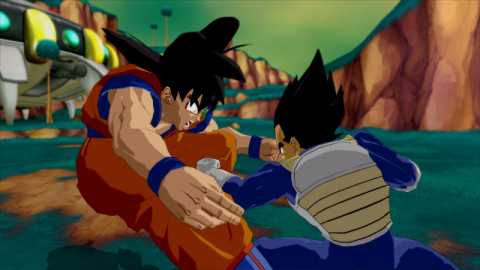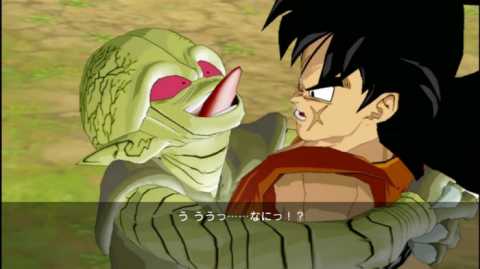It's no secret that I'm a fan of the Dragon Ball Z series. I've always thought if any property could be turned into a great fighting game it had to be DBZ. It has engaging characters with over-the-top powers and an epic sense of action. So, you're probably saying to yourself “Oh boy, fanboy Vinny is going to give Burst Limit 18 stars!” Well, as much as I'd like to tell you that this is the DBZ game to challenge the non-believers, it's just not quite there yet. If you're a fan of the Dragon Ball Z series you'll be happy to know that Dragon Ball Z: Burst Limit provides enough winks and nods to satisfy despite its relatively limited campaign and roster. Judged strictly as a fighting game, Burst Limit comes up short in terms of depth and diversity.

For me, the bread and butter of a Dragon Ball Z game is how well the story and the actual fighting are integrated into the game. If you think you've seen every conceivable rendition of Goku vs. Frieza, rest assured, Burst Limit forges some new paths in this well-trodden area.
The Z Chronicles will take you through the Saiyan Saga, the Frieza Saga and the Cell Saga, which is fine, because everyone knows all that GT crap that came later is bonkers. Still, it does seem a little abridged considering previous Dragon Ball Z games included every saga, season, movie, fan fiction, “what-if scenario” and even some stuff that was just plain made up. Each saga has approximately 15-20 battles that progress in a linear fashion, with the occasional optional battle thrown in. Burst Limit does a great job of letting you play as the appropriate character in each battle, avoiding the awkward and frustrating occasions of demolishing an opponent only to discover that in the following story elements you actually lost the fight. This was a serious disconnect in previous iterations of the franchise, and it's a welcome improvement in the implemenation of the storytelling. The game also tries to capture some of the ever-escalating intensity of each battle by peppering in story elements throughout a battle. If you meet certain conditions within a fight you'll unlock little scenes called Drama Pieces. These Drama Pieces not only share more of the decidedly thin narrative with you, but they will also imbue temporary buffs and debuffs in you and your opponent. These can range from a temporary increase in Ki regeneration to actually inflicting some minor damage on your opponent. These scenes are charming for fans and they are a clever way to reference particular moments during your favorite battles.

Now, when it comes to translating the...robust...Dragon Ball Z story into video game form, the series has had mixed results. Burst Limit takes the approach of "what you don't know won't hurt you." It strips down the story elements into the most significant fights throughout each saga and gives you only a few lines of exposition before and after each battle. If you're a fan of the series you can usually fill in the narrative gaps, but if you are new to the series you will be completely lost. You'll jump from Earth to Namek with no explanation; watch characters die and mysteriously resurface a few battles later; and, sadly, be left wondering if you're missing something or if this what Dragon Ball Z has to offer. For the folks in the know, scenes from the anime are authentically reconstructed in-engine, sometimes shot for shot, but for the uninitiated, the non sequiturs in the story will leave many scratching their heads.
Now here's my biggest gripe with the Z Chronicles, and possibly the entire game. After you complete a saga you can watch a movie that includes great narrative moments that would have tied together many of the battles in which you just participated. It's really a shame these scenes couldn't be used in conjunction with the conspicuously missing narrator to flesh out more of the story and add a bit of investment and meaning to the battles. It's almost as if all the elements were there for this great narrative in the story mode and someone was like “Eh, this is taking too long, throw it all in at the end.” Big mistake, and a real disappointment.
The fighting in Dragon Ball Z: Burst Limit is fairly pedestrian and you won't have a problem jumping into the shoes of other characters. There are two main physical attack buttons, one for strong and one for regular attacks, and a ki blast button. In addition you have buttons for blocking, throwing and a button which acts both as a more powerful ki-enhanced block and a sort of ki-toggle to enhance your other attacks. If you're new to the series, you can think of ki as magic or mana; it's what allows your character to perform his most powerful moves.

There isn't much in the way of variety from each character, aside from different special moves. With the exception of Piccolo, who has a considerably longer reach than other characters, you'll be using the same basic attacks and techniques throughout the game. The AI won't let you spam special moves over and over, so you'll have to get in close for some fisticuffs, but once you get familiar with the controls you'll find yourself pulling off the same sequence of moves again and again. That being said, the battles are generally fun and move at a pretty good pace. The Drama Pieces add enough of a tweak during a battle that if you don't move your butt to finish off an ailing opponent he can quickly turn the tables and win. The ability to select up to three unique Drama Pieces and customize your character with different Ultimate attacks at the outset of a multiplayer fight adds some depth to the fighting mechanic, but the immediate impact of your choices won't be apparent until you have become deeply invested in the subtleties of the game.
Speaking of multiplayer, I found that it was pretty standard fare for the local mode and hit or miss when it came to the online variety. I encountered some pretty serious lag depending on connection speeds, but when the pings were low the game seemed to handle itself well. There's a surprising amount of timing required to block and dodge moves, so lag will definitely cause more than a few frustrations during a match.

Considering the original Dragon Ball Z anime first aired almost 20 years ago, watching high-definition Kamehamehas is a treat. The game looks great, and while it would have been nice to see some of the cosmetic damage present in other Dragon Ball Z games, the overall presentation is well-executed. As a fan of the English-dubbed anime, I found the voice acting solid, but not exceptional, with some characters sounding better than others. There is an option to play using the Japanese voices, but for me, the English voices are what I associate with the series and found no reason to switch, unless I was really aching to have Goku sound like a 12-year-old boy.
Dragon Ball Z: Burst Limit is definitely more a game for those familiar with the series than players looking for a deep, competitive fighting game. While it's visually engaging, those without an interest in the actual Dragon Ball Z franchise will find the fighting too simplistic to be rewarding. I loved seeing the characters realized in their most detailed and expressive incarnation to date, but unfortunately Burst Limit fails to integrate the over-the-top nature that the anime, and even the developer's previous DBZ game, Dragon Ball Z: Budokai 3, captured so well.